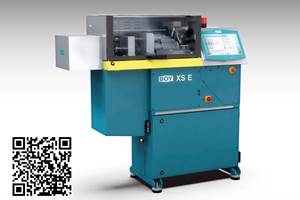With This New Process, You Can't Be Too Thin or Too Fast
Minneapolis custom molder Midwest Plastics Components (MPC) hopes that helping to pioneer a novel high-speed injection molding concept will give it a leg up in the emerging micro-molding market for precision thin-wall parts that weigh less than a gram.
Minneapolis custom molder Midwest Plastics Components (MPC) hopes that helping to pioneer a novel high-speed injection molding concept will give it a leg up in the emerging micro-molding market for precision thin-wall parts that weigh less than a gram. MPC is the first molder in North America to make commercial use of X-Melt, a process developed in 2001 by machine builder Engel Austria GmbH.
It eliminates the need for a gas accumulator to achieve super-high-speed injection. Instead, X-Melt exploits the natural elasticity of plastic melts. It uses the screw and a shutoff nozzle to pressurize the melt to a very high but defined level in the machine barrel. When the valve is opened, the compressed melt expands in the cavity at an explosive rate, even faster than can be achieved with an accumulator. In effect, X-Melt uses the energy stored in the pressurized melt to fill the mold without moving the injection ram. X-Melt reportedly uses one-third to half as much energy to fill the mold and simplifies the process by eliminating the need to determine injection-speed and holding-pressure profiles.
MPC employs this technology to attack a niche market for tiny surgical implant devices used in vascular, ocular, facial, and nerve-regeneration applications, as well as devices that aid in reattachment of a ligament or tendon to a joint. MPC uses special polyester resins to mold resorbable devices. “With X-Melt, we make long, thin, flexible products that allow for smaller incision sites and can compete with sutures. We can injection mold products that previously had to be extruded or did not exist,” says Dale Gildemeister, MPC project engineer.
“We haven’t found a limit to how thin we can go yet,” says Gildemeister. “We have molded a tube 22 mm long with a 0.25-mm wall thickness. We are looking at thinning that same tube down to a 0.07-mm wall,” he adds. MPC has found X-Melt effective for parts weighing 4 g or less.
All-electric precision
MPC began in the 1960s under the name McCourtney. Today, it operates 47 injection presses from 17 to 700 tons to serve automotive, defense, industrial, and medical markets. MPC has four clean rooms of class 100,000 and class 10,000.
MPC uses X-Melt on a 60-ton Engel E-Motion all-electric press fitted with a special screw, barrel, hot-runner system, and shut-off nozzle that are all able to withstand pressures up to 54,000 psi. It also features adaptive software that minimizes variation in the locking behavior of the non-return valve. The press was supplied by Engel Canada, Guelph, Ont., and the hot-runner system and shutoff valve were designed in cooperation with Mold-Masters Ltd., Georgetown, Ont.
Engel says the X-Melt process requires its E-Motion line of all-electric machines, due to the critical requirement for controlling screw position, which helps control the pressure applied to the melt. The system reportedly can deliver parts with weight variation as tight as ±0.03%, which compares with ±7% achieved with accumulator injection.
This is where MPC is looking to gain its edge in medical molding. “With X-Melt, the standard deviation in cavity pressure over 100 shots is just 13 psi,” says Gildemeister. “We are making a shift in our strategy from trying to achieve machine repeatability to achieving polymer repeatability.”
MPC has four thin-wall applications for X-Melt. Mold fill times are no more than 1.5 millisec. It takes some trial and error to determine the correct pre-compression position and the operating profile of the shutoff valve, says Gildemeister.
Using X-Melt, MPC can consistently produce parts from 0.4 to 0.8 g with wall thickness down to 0.1 mm. “We have made parts down to 4 g with other methods, but not thin-walled parts. We could achieve a 0.6-mm wall using special flow enhancers in the cavity, but the enhancers could generate material waste, which is expensive when the polymer costs several thousand dollars per kilo,” Gildemeister says.
Related Content
New Machine Range Features Adjustable Clamp for Micromolding
The Boy XS E, successor to the XS series, features servodriven pump drives and different clamp configurations, as well as a special mold holder for optional micromolding operation.
Read MoreIMM Cells Display Communications, Energy Measurement and Energy Recovery
NPE2024: Wittmann will feature five injection molding machines incorporating its range of robotics and auxiliaries, with all products employing industry 4.0 communications, energy measurement and a brand-new red color.
Read MoreMidtonnage Hybrid Range With Compact Footprint Launches
NPE2024: Milacron has the global launch of its new M-Series injection molding machine line featuring a large clamp stroke as standard in a line of midtonnage, compact-footprint machines.
Read MoreSlimmer All-Electric Press Debuts
A slimmed-down version of Engel’s all-electric, e-mac injection molding machine is among eight displays, which also include LSR micromolding, quick mold changes and a cube mold.
Read MoreRead Next
Lead the Conversation, Change the Conversation
Coverage of single-use plastics can be both misleading and demoralizing. Here are 10 tips for changing the perception of the plastics industry at your company and in your community.
Read MoreTroubleshooting Screw and Barrel Wear in Extrusion
Extruder screws and barrels will wear over time. If you are seeing a reduction in specific rate and higher discharge temperatures, wear is the likely culprit.
Read MoreAdvanced Recycling: Beyond Pyrolysis
Consumer-product brand owners increasingly see advanced chemical recycling as a necessary complement to mechanical recycling if they are to meet ambitious goals for a circular economy in the next decade. Dozens of technology providers are developing new technologies to overcome the limitations of existing pyrolysis methods and to commercialize various alternative approaches to chemical recycling of plastics.
Read More











.png;maxWidth=300;quality=90)













